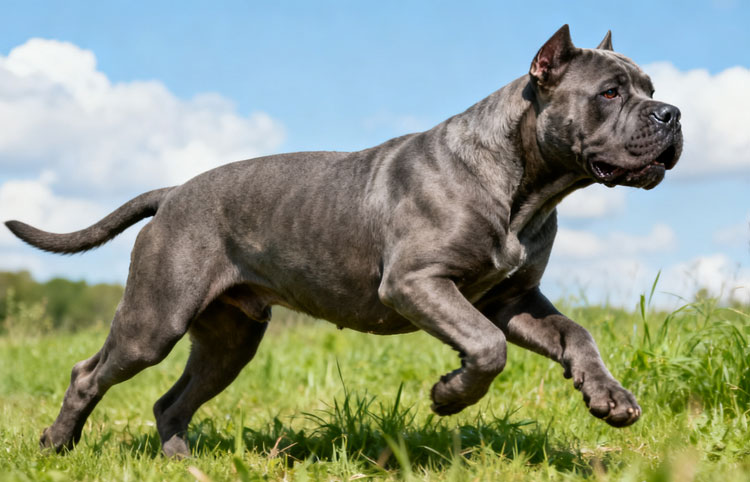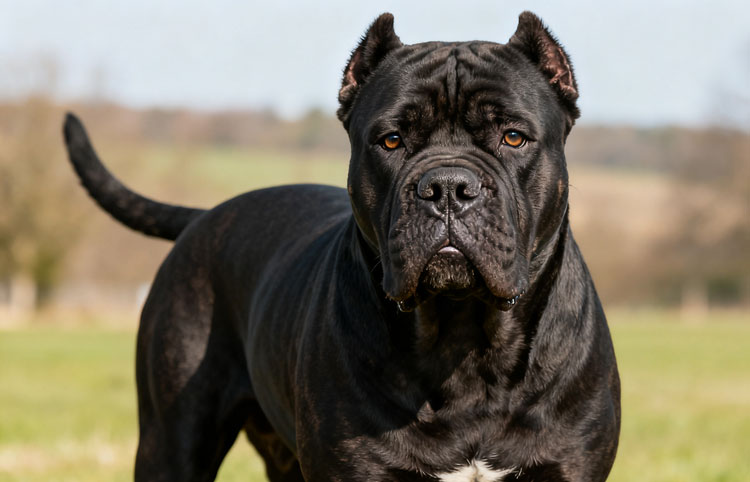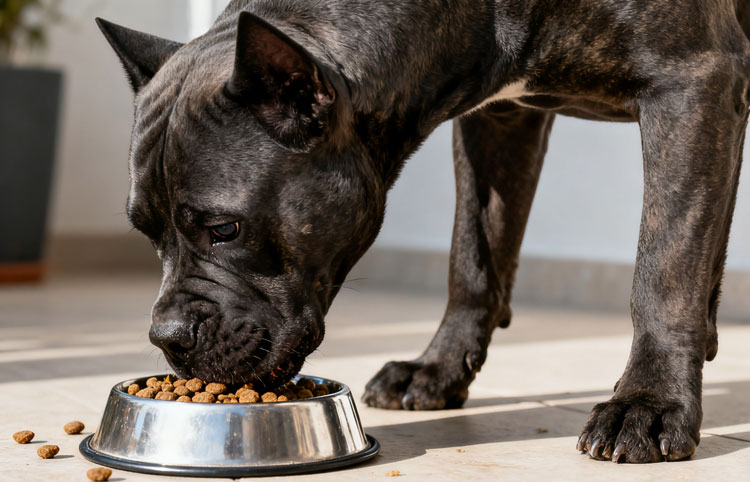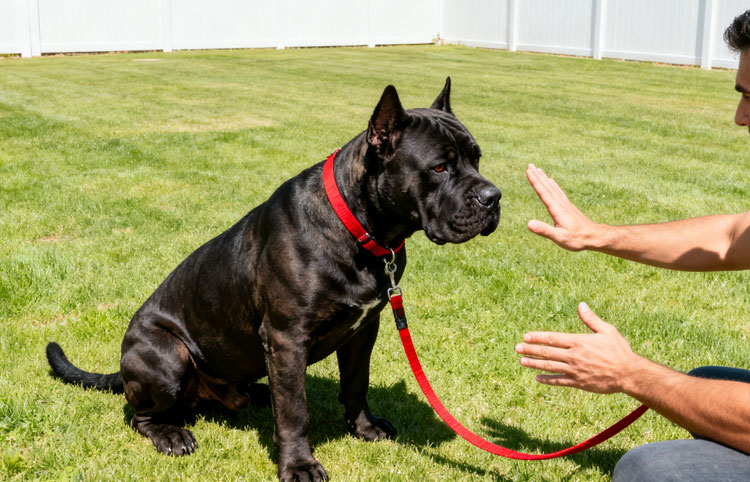Cane Corso Health Care and Breeding Guide
The Cane Corso originates from Italy, bred from ancient mastiff lines with a lineage stretching over two millennia, firmly establishing it as a premier large-breed guard dog. It possesses a bold and decisive temperament, combining fierce drive with exceptional endurance. As a compact mastiff breed, its explosive power rivals that of larger mastiffs. Historically, it was primarily used to drive cattle to slaughterhouses, where it would latch onto the animals to facilitate butchering. It was also employed in hunting large game like wild boar, excelling in the field due to its swift movements and keen reflexes. In terms of size, males typically stand 64-68 cm at the shoulder, while females are slightly shorter, around 60-64 cm.
I. Cane Corso Lifespan
Cane Corsos generally live 10 to 14 years, which is relatively short compared to many other breeds. Their actual lifespan depends heavily on how they’re cared for: with attentive care and minimal illness, they often exceed ten years; but neglect and frequent health issues can significantly shorten their lives.
II. Cane Corso Price
Market prices for Cane Corsos vary considerably, ranging from $450 to $1,500. A decent-looking puppy can be purchased for around $450. For a fully black-coated, energetic, well-proportioned dog with pedigree papers, the price jumps to approximately $3,000. Those with ordinary appearances and uneven coat colors can be acquired for $300 to $450; mixed-breed Cane Corsos are even more affordable, available between $285 and $450.
III. Selecting a Cane Corso
1. Observe the Eyes: A healthy Cane Corso has bright, clear eyes with clean, dry areas around them, free of excess discharge or debris. If you notice redness, a white film over the eyes, excessive discharge in the corners, or protruding eyes, the dog is likely unhealthy and should be avoided.
2. Check the ears: Focus on smelling the ear canal for any unusual odors and inspect for foreign objects. A healthy Cane Corso should not have dark brown or black earwax in the ear canal. When selecting, gently fold back the ear flap to carefully examine the inside for abnormal discharge.
3. Inspect the mouth: First, check for foamy discharge. Then lift the lips to examine the color of the gums and tongue. A healthy tongue should be pink. If the Cane Corso is malnourished, has parasites, or suffers from congenital anemia, the gums may appear pale.
4. Observe the nose: A healthy Cane Corso’s nose should feel moist. However, if the dog has a cold, allergies, or an upper respiratory infection, it may have a runny nose. In severe cases, it may cough up phlegm, and later the discharge may turn milky white, yellow, or even greenish pus.
5. Check the coat: Feel the Cane Corso’s fur for smoothness and shine. Look for areas of excessive shedding, reddened skin, or signs of fleas crawling.
6. Examine the bones: Run your hands from the front paws toward the head, hindquarters, and legs, noting any signs of discomfort. gently move its joints to see if it resists certain motions, which can indicate fractures or bone injuries.
7. Assess mental state: A healthy Cane Corso appears alert, bounces with energy, maintains high vigilance, and responds quickly when touched. Avoid selecting one that seems lethargic, unresponsive to movement, or unresponsive to calls.
IV. Advantages of the Cane Corso
1. Loyal and Gentle: Cane Corsos are exceptionally devoted to their owners and enjoy interacting with them. They are quiet indoors and gentle with other household members, especially fond of playing with children. They tolerate even overly boisterous play from youngsters.
2. Intelligent and Trainable: The Cane Corso possesses above-average intelligence and learns quickly. Whether mastering commands or performing tricks, it adapts swiftly and cooperates well during play sessions with its owner. With proper guidance, it excels in obedience training.
3. Brave and Resilient: The Cane Corso is characterized by its boldness and perseverance, possessing excellent endurance. It won’t easily give up when faced with challenges and maintains its courage even in difficult situations.
4. Stable Temperament: The Cane Corso is not easily agitated by external noises. It has a strong protective instinct toward family members and won’t attack strangers without provocation. When real danger arises, it will immediately step in to protect its family and property, proving exceptionally reliable.
V. Drawbacks of the Cane Corso
1. High Exercise Requirements: Due to its large size and substantial appetite, ample exercise is essential for maintaining health. This necessitates owners having sufficient space and dedicating time for regular walks and physical activity.
2. Strong Vigilance: It exhibits significant wariness toward strangers and other small animals. If it perceives danger to itself or its owner, it may directly charge and attack.
3. Requires Focused Obedience Training: They can be quite headstrong, especially males, necessitating consistent training from puppyhood. Without early guidance, they may become stubborn and difficult to manage as adults.
4. Limited Adaptability: They are fiercely protective of their territory and their owners, making them less suitable for urban living. In confined spaces, they are more likely to display hostility or aggression toward other animals or visitors.
VI. Grooming the Cane Corso
1. Brushing the Coat: The Cane Corso’s coat isn’t particularly short, but if not brushed regularly, it can easily become matted and tangled. It’s recommended to brush at least once a week using either a comb or brush. Be gentle while brushing to avoid pulling on its skin.
2. Bathing: The Cane Corso also needs regular baths to keep its coat clean and shiny. Once a month is generally sufficient. Always use dog-specific shampoo; human shampoo or soap can irritate their skin and coat.
3. Trimming: To maintain a neat appearance, trim excess hair periodically—especially around the ears, neck, belly, and rear. Use clippers or scissors to achieve a clean, even look.
4. Nail Trimming: Cane Corso nails require regular trimming. Trim the hair around the nails and use nail clippers to keep the nail tips even. This ensures healthy nails and prevents discomfort when walking.
5. Oral Hygiene: Cane Corsos are prone to bad breath and tartar buildup. Regularly clean their mouths using dog-specific toothbrushes and toothpaste, or other suitable oral care tools.
VII. Cane Corso Care
1. Diet: When bringing home a Cane Corso puppy, first ask the previous owner about its feeding routine—what food, portion size, and feeding times. Initially, stick to the original regimen for about a week before gradually adjusting the diet. Sudden changes in food, environment, and owner—especially after long-distance transport—can cause stress, weaken immunity, and lead to digestive issues or illness. Additionally, Cane Corso puppies have delicate digestive systems. Feed them low-fiber, soft, easily digestible foods. Some owners spoil their puppies with excessive meat, leading to digestive upset within just 1-2 days. For puppies under 3-4 months old, porridge-like meals or dry kibble softened with warm water are ideal. Other foods may cause indigestion or diarrhea. Avoid giving puppies milk, as it can also cause diarrhea. A mother dog’s milk is exceptionally high in protein—three times that of cow’s milk and 7.5 times that of human milk—making it high in protein, high in fat, and low in lactose. In contrast, cow’s milk and the powdered milk we consume are low in protein, low in fat, and high in lactose, which differs from a puppy’s nutritional needs. Puppies lack sufficient lactase enzymes to digest lactose. Excessive milk causes lactose fermentation in their stomachs, leading to diarrhea. Therefore, 2-month-old puppies should be fed high-protein foods supplemented with vegetables, providing nutrition comparable to 4-5-month-old human infants’ complementary foods. For example, finely shred chicken breast or lean beef, mix with vegetables, and blend in breadcrumbs or rice. Feed 3-4 times daily. Supplement with calcium powder (or bone meal, active calcium) and add 1-2 drops of vitamin A/D liquid to support bone development.
2. Elimination: Monitor your Cane Corso’s bowel movements regularly. Bowel movement frequency changes with age: a 1-month-old may defecate several times daily, while a 2-month-old typically does so about 3 times. Frequency also depends on diet—meat and rice result in smaller, less frequent stools, whereas starchy foods increase both volume and frequency. Monitor stool color, odor, and presence of parasites. Normal stool should be formed, firm yet soft, and yellowish in color. If fed excessive meat or liver, stools may appear dark. Urination frequency also relates to age: at one month old, puppies typically urinate every two hours; by two months, this reduces to 5-6 times daily. Healthy urine is pale yellow or clear. Darker first-morning urine is normal, but persistently concentrated urine throughout the day may indicate illness—seek immediate veterinary care.
3. Training: Starting at 2 months old, begin teaching good habits. First, choose a name for your Cane Corso and call it frequently so it associates the name with being addressed. Gradually form a conditioned response where it comes when called. Additionally, teach it to use a designated potty spot. Puppies under 4 months old cannot hold their bladder and will relieve themselves whenever the urge arises. Only after 4 months can they gradually learn to follow a regular potty schedule.
4. Health: Maintain a consistent routine for your Cane Corso puppy. Feed it at regular times with measured portions and balanced nutrition. Avoid letting it become a picky eater, as this can lead to nutritional imbalances. Be cautious not to overdose on vitamins (especially Vitamins A and D) or let it become calcium deficient. Feed it until about 70-80% full—never stuff it. Never feed spoiled food, as this can cause diarrhea or poisoning.
VIII. Foods Cane Corso Dogs Must Not Eat
1. Seasonings used in human cooking—such as soy sauce, salt, MSG, sugar, Sichuan pepper, star anise, and ketchup—are strictly prohibited.
2. Chocolate, grapes, scallions, and onions are also harmful and should never be fed.
3. Avoid indigestible items like soybeans and sesame seeds.
4. Squid and fish bones should be avoided as they can get stuck in the throat or scratch the esophagus and digestive tract.
5. Ensure constant access to clean, fresh water in a clean bowl. Avoid untreated water and change it regularly—never leave it for days. This guarantees hydration whenever needed.
IX. Training Your Cane Corso
1. Training for Cane Corsos can begin as early as 2 months old. This stage focuses on establishing good habits and crucial socialization.
2. The period between 2-4 months is the most critical socialization phase for Cane Corsos—seize this opportunity. Training at this stage should be guiding, not forcing or suppressing. Don’t demand immediate obedience to commands. The emphasis should be on stimulating its intellect, building a positive relationship, fostering a good temperament, and introducing it to potential future training concepts. This is sufficient for this stage.
3. By 8 months of age, you can begin teaching obedience and preliminary bite work training, such as practicing biting objects. During this phase, emphasize encouragement to build confidence and courage. Avoid pressure, making training feel like a fun activity. For protection-related training, wait until its personality matures—around 1.5 years old is ideal. Proceed step by step without rushing.
4. During training, use clear and simple commands. Dogs have limited comprehension, so commands should be straightforward, without accents, and avoid frequent changes or excessive repetition. Cane Corsos are sensitive; unclear commands or harsh tones can cause resistance, making future training difficult.
5. Avoid praising or rewarding your dog indiscriminately. For instance, don’t praise or give treats for minor actions. This confuses them about when praise is deserved, leading them to perform random actions expecting rewards. Over time, this diminishes training effectiveness and renders rewards useless.
6. If you catch it misbehaving or performing an action incorrectly, address it immediately and correct it. Don’t wait to reprimand it later. The Cane Corso has a poor memory for past events. If you scold it after the fact, it won’t understand what it did wrong, leading to confusion. This makes it impossible for the dog to learn what is and isn’t acceptable behavior.
X. Common Health Issues in Cane Corsos
1. Fungal Infections: A frequent cause of skin problems in Cane Corsos, leading to hair loss and redness. Highly contagious—consult a vet immediately if noticed.
2. Mites: Typically found under the skin, on the belly, or around the thighs, mites cause small red bumps and hair loss around the lips with reddened skin. If present in the ears, brown discharge may appear in the ear canal, and the dog will scratch its ears constantly due to itching.
3. Fleas and Lice: These parasites are often visible on the body, inner thighs, or neck fur. Regular bathing and flea/louse prevention are essential to reduce infection risk.
4. Eczema or Herpes: Common skin conditions causing blisters or pus-filled sores on the belly and inner thighs. A veterinary diagnosis is necessary for appropriate treatment.
5. Scabies: This highly contagious condition involves mites burrowing into hair follicles. When the dog’s immunity weakens, it can spread into a full-blown skin disease. It starts with localized hair loss and gradually spreads across the body.
6. Common Cold: If a Cane Corso catches a cold, it may cough, have a runny nose, sneeze, or tear up. Its nose may become dry, cracked, or red. The dog may appear lethargic and lose its appetite.
7. Diarrhea: Diarrhea can result from gastroenteritis, digestive issues, exposure to cold, or bacterial infections caused by parasites. During diarrhea, stools are typically watery, often appearing white or green.
8. Heatstroke: During hot, stuffy summer days, Cane Corsos are prone to heatstroke. Symptoms include loss of appetite, lethargy, reluctance to move, and in severe cases, convulsions.
admin
-
Sale!

Washable Pet Cooling Pad for Cats and Dogs
$10.99Original price was: $10.99.$9.99Current price is: $9.99. This product has multiple variants. The options may be chosen on the product page -
Sale!

Washable Cat Window Hammock Cooling Bed
$23.99Original price was: $23.99.$22.99Current price is: $22.99. -
Sale!
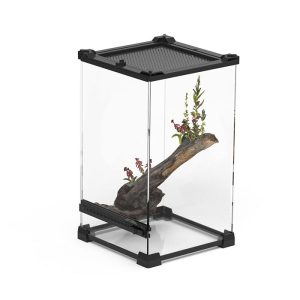
Tropical Amphibian Rainforest Tank, Lizard Cage
$38.99Original price was: $38.99.$36.99Current price is: $36.99. -
Sale!
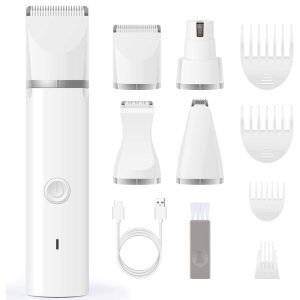
Silent 4-in-1 Waterproof Charging Dog Hair Trimmer
$49.88Original price was: $49.88.$47.99Current price is: $47.99.

